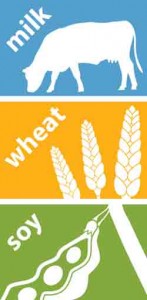The U.S. Food and Drug Administration (FDA) is using a three-pronged approach to reduce the number of leading cause of food recalls it requests: undeclared allergens. Ingredients such milk, eggs, fish, crustacean shellfish, tree nuts, wheat, peanuts, and soybeans cause serious, sometime life-threatening reactions for those with allergies.
 The agency says that by researching the source of labeling errors; working with industry to develop best practices; and exploring new allergen testing methods it can improve the labeling process and minimize the problem.
The agency says that by researching the source of labeling errors; working with industry to develop best practices; and exploring new allergen testing methods it can improve the labeling process and minimize the problem.
All food regulated by the FDA is required by federal law to have labeling that identifies major food allergens. Products that don’t are considered misbranded and can be seized by FDA, but most companies recall such food products voluntarily.
Consumer reporting is a big part of the process, said Steven Gendel, Ph.D., an FDA food allergen coordinator.“We look at every complaint to determine the appropriate course of action.”
Between September 2009 to September 2012, about one-third of foods reported to FDA as serious health risks involved undeclared allergens, said Gendel. The foods most often involved were: bakery products; snack foods; candy; dairy products and sauces such as salad dressings, sauces and gravies. The allergens most often involved were milk, wheat and soy.
One of the biggest offenders in the candy category was dark chocolate. Often snack bars or candies coated with dark chocolate would have labels that did not declare milk as an ingredient and in some cases were labeled “dairy-free” or “vegan.”
Some problems stemmed from the use of the wrong label in situations where similar products sold in similar packaging contain different ingredients. Other problems were associated with the use of new technologies, such as computerization. These problems could likely be addressed through improved industry awareness and simple changes at production facilities, Gendel said.
The enzyme-linked immunosorbent assay (ELISA) is the most common test for allergies because it’s inexpensive and easy to use, said Mark Ross, Ph.D., an FDA chemist. But it has it drawbacks. It can produce false positive results, and it can’t tell some similar allergens apart.
FDA researchers are developing a allergen test that uses mass spectrometry a more effective method, said Ross “If someone wants us to analyze a food for peanut allergen, with mass spectrometry we can detect and differentiate among the 11 different allergenic proteins in a peanut,” he says. FDA researchers are also developing DNA-based methods to detect fish and shellfish allergens.
(Graphic is courtesy of the FDA.)





Interesting article. Those of us with corn allergy don’t even have truth in labeling to warn us that a food is not safe for us. Of course, since corn is dumped into almost all of our food supply, there would be constant recalls. Probably, that is why corn is not allowed to be called an allergen, and is falsely claimed to be rare, or doesn’t exist. Corn is in the grass family, along with wheat, and grass allergies are very common. I’m allergic to corn, grass and some other members of the grass family. As are many other people. I have Celiac and must avoid all wheat and gluten ingredients, but I’m not allergic to wheat or any other food in the ‘Big Eight’ that are allowed to be called food allergens. I’m allergic to mustard, which is a common ‘labeled’ allergen just across the border, in Canada. Not allowed to be an allergen in the US, though. Go figure, huh.